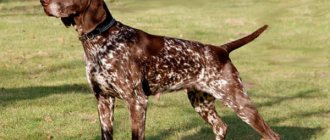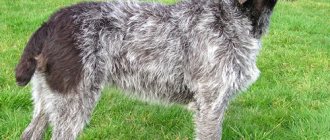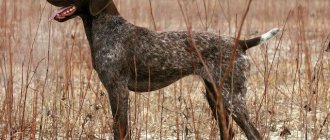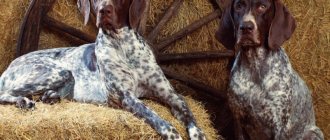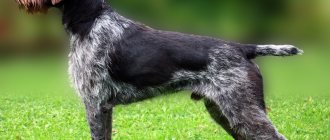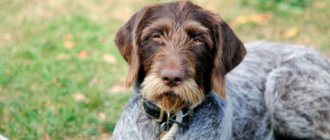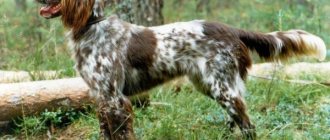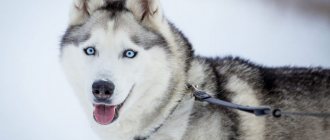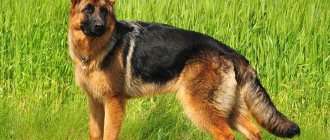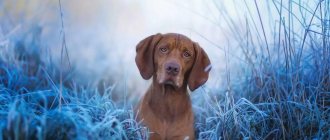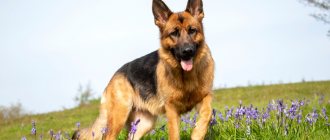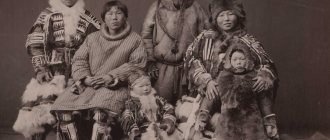Shorthaired Pointer care and maintenance
Caring for a shorthaired pointer is not at all difficult. The breed is short-haired, shedding seasonally
First of all, it is important to monitor the coat of the cop
The coat must be combed several times a week, using a special brush and a massage mitt. During the molting period, comb your dog more often, this will rid you of hair in the apartment.
It is not recommended to bathe often, once a month or when soiled, otherwise the coat will lose its natural shine and fatty cover, which protects it from contamination. Representatives of the breed are excellent swimmers and love to swim in ponds or rivers. You should not let your dog go outside in the winter immediately after bathing, otherwise it may catch a cold. For bathing, use special shampoos for this breed, or practice dry cleaning.
Photo of shorthaired pointer waiting
Pay special attention to your ears - they should always be dry and clean. Any dirt can be carefully removed using a cotton swab or damp cotton pad.
Always check your ears after walking.
Eyes: Watch your shorthaired pointer's eyes, they should be shiny and clean. For sour eyes, wipe with a damp cotton pad soaked in weak tea leaves. If there is severe souring and excessive tearing, the dog must be shown to a veterinarian.
The claws are trimmed once a month, using a nail clipper for large breeds; often, during long walks, they get scratched on the asphalt.
In the photo, the shorthaired pointer is resting while hunting
It is better to accustom a dog to hygiene procedures from puppyhood, then the owner will not have problems caring for the pet, and the dog will enjoy communicating with the owner.
Ticks and fleas
The German pointer is a hunting breed, and there is no doubt that the dog and its owner will spend time in nature, running through forests, parks, and bushes. There is a real threat of picking up ticks.
To prevent the parasite from causing harm, be sure to treat the shorthaired pointer once a month with a parasite repellent (ticks, fleas). Your veterinarian can advise which product to use. The product is applied to the area between the dog’s shoulder blades, closer to the neck, in a place inaccessible to the tongue. After application, do not bathe for 10 days; on the first day, do not let children pet the dog.
Walks: shorthaired pointer - needs long walks with physical activity. In the absence of proper stress, he will turn into an uncontrollable hyperactive pet that will “destroy” your apartment. Therefore, if you are not able to provide your dog with active and long walks, then this breed will not suit you.
Breton epañol
- Height: from 46 to 52 cm
- Weight: from 14 to 18 kg
- Life expectancy: 12-15 years
- Personality: attentive, intelligent, agile, adaptable, playful
The longest of the sporting breeds, the Breton Epagnole has square proportions, the height at the withers being equal to the length of the body. The combination of long limbs and light bones gives the Breton Spaniel remarkable agility and speed. Some puppies may be born tailless . The coat of this breed is much less dense than that of spaniels and can be straight or wavy.
In the mid-1800s, the French crossed their small land spaniels with English setters in an attempt to develop a dog more suited to their needs. Some of the descendants turned out to be tailless or short-tailed. More importantly, they were excellent hunters with a strong sense of smell. These dogs soon became popular not only among French nobles, but also among poachers, because they could both point and catch prey, and were extremely obedient - qualities necessary for the clandestine activities of poachers.
The Breton Epagnole is an extremely athletic, energetic dog that is capable of running for long periods of time. They are swift and curious, always on the lookout for birds or entertainment.
IMPORTANT! These dogs have an independent nature, but they are also sensitive and very responsive to human instructions. Breton Spaniards make good pets if they receive daily mental and physical exercise. If you don't give them enough stress, they can become destructive.
This is a hardy dog that does not require special care. This breed's main requirement is plenty of exercise, with at least an hour of exercise—not just walking—every day. The coat is not particularly thick or long, but requires brushing once or twice a week.
Care and maintenance
The shorthaired pointer is a large dog, so it is not suitable for keeping in an apartment. You can’t let him on beds and sofas, which means you’ll have to give your pet a separate room.
- The bed should be in a dry and warm place without drafts.
- This breed has floppy ears, so they need to be checked once a week, as well as cleaned. You can clean it with a damp cloth.
- You need to wipe your eyes every day. Usually, this is done by moistening a napkin with a weak solution of tea.
- Nails can be trimmed once a month with a special nail clipper.
Nutrition
The shorthaired pointer can be fed with both dry balanced food and natural food.
The puppy needs to be fed 4-5 times a day. Their diet should contain only dairy and low-fat fermented milk products. But from the third month of life, the pet is gradually weaned off dairy products. At this age it is better to switch to solid foods.
Starting from 5 months, the puppy is fed 3 times a day. Now you can't leave the bowl with leftovers. But if the puppy finishes everything and then licks the dishes, then you need to increase the portion.
An adult dog is fed 2-3 times a day. Her diet should include foods containing proteins, fats, carbohydrates and fiber:
- Meat products: beef, veal, chicken and cartilage;
- Dairy products: kefir, cottage cheese (low-fat), yogurt (natural), fermented baked milk;
- Porridge: oatmeal, rice, buckwheat, barley;
- Vegetables: carrots, zucchini, pumpkin, tomato.
Not every meat can be given to Kurzhaar, and some other foods are also prohibited:
- Pork;
- Lamb;
- Duck;
- Goose;
- Sausage;
- Salo.
It is also necessary to exclude from the diet everything sweet, fatty, fried and spicy.
Health
On average, German cops live up to 14 years, but there have been cases when dogs lived up to 30 years. To prolong the life of a pet, it is necessary to provide it with serious exercise. It is also necessary to carefully monitor the appearance of ticks and worms. This is a large breed, which means it is more difficult to fight parasites.
Vaccinations
For two months of a puppy’s life, maternal immunity protects it. And then it is necessary to vaccinate him.
- The first vaccination is given to the puppy at 2-2.5 months. It will protect against hepatitis, plague and enteritis. But since one vaccination will not be enough, revaccination will need to be spread out over the whole year.
- Veterinarians recommend vaccination against rabies closer to the year. This is due to the fact that such a vaccination will hit the puppy’s immunity harder than all others. For the same reason, the baby should not be taken outside, and any contact with other animals must be prevented.
Diseases
The shorthaired pointer is a breed that rarely needs the help of a veterinarian. However, the breed has its own congenital diseases. Here are the most common ones:
- Bloating;
- Otitis externa (damage to the tissues of the external auditory apparatus);
- Cataract (clouding of the lens of the eye);
- Melanoma (malignant tumor of melanocytes - pigment cells);
- Entropy (eyelids turned inward);
- Eczema (acute inflammatory skin disease);
- Hip dysplasia (congenital hip dislocation).
Walk
The Shorthaired Pointer should not be taken for walks to dog parks. This breed is very susceptible to disease. At such sites you can easily catch the infection from other dogs. In addition, the dog may chase a smaller dog and become uncontrollable.
- You can accustom your puppy to walks as early as 1.5 months. However, this should not be done for about 2 weeks after vaccination. The duration of walks should not exceed 10-15 minutes. After all, at this age, walking should accustom the puppy to going outside.
- Starting from the age of one year, the dog should be walked 3 or more times a day. This breed is very active, so it is necessary to provide serious exercise. You need to play a lot with your pet and do all possible strength exercises.
- The coat needs to be brushed a couple of times a week. To do this, use a special brush or massage mitten. When the dog begins to shed, it is better to increase the number of combings.
- Bathing once a month is enough. If you do water procedures more often, the coat will lose its shine and protective fat layer. This can cause skin inflammation.
- In summer, the dog can be bathed in rivers and ponds. Kurzhaar is an excellent swimmer, which means he will only like such procedures. In winter, after bathing, you should not immediately take your dog outside. She might catch a cold. It is better to bathe with a special shampoo, which can be bought at pet stores.
Health and illness
The German pointing dog Kurzhaar is distinguished by its excellent endurance and good health. These pets quickly adapt to any climate, have no fear of cold and wind, and can also get into the water before the first frost.
The list of hereditary diseases is typical for most large breeds:
- Volvulus. The occurrence of such a disease requires immediate surgical intervention.
- Hip dysplasia can be either congenital or acquired. Treatment depends on the severity of the disease: the use of restraining therapy or replacement of an unhealthy joint.
- Impaired functioning of the thyroid gland. In most cases, it manifests itself as a hormonal deficiency.
- Otitis.
- Raw type eczema - manifests itself as continuously weeping wounds. The inflamed areas itch, and over time hair falls out. Pathology is detected by scraping. It is treated in accordance with the identified pathogen.
- Lick granuloma - continuous licking of the front paws. The main reason in most cases is simple boredom. There is no special treatment. The key advice is to provide the animal with stable communication. Medicines are prescribed only if secondary infections are detected.
- Von Willebrand disease is a hereditary type of pathology. Breeding sick dogs is excluded.
- Cataract.
- Epilepsy attacks.
Lifespan
Literally every disease of the breed is associated with defects at the genetic level, formed as a result of the reproduction of defective dogs. Genetically healthy pets remain energetic until old age. The lifespan of the Kurzhaar is 12–14 years.
Shorthaired Pointers live longer if:
- provide them with a balanced diet, proper care and the required exercise;
- Vaccination on time;
- carry out treatment against parasites;
- make sure that the Kurzhaar puppy's grandparents have undergone genetic testing.
Mistakes when raising a small cop can lead to problems with its health in the future, which directly affects how long the pet lives.
Mating
Puberty in female Shorthaired Pointers occurs at approximately 7-8 months, in males - 1-1.5 months later. At this time, strong physiological changes occur in the dog’s body, and behavior changes. Dogs may become more aggressive.
- During the period of estrus, females have noticeable red discharge. The pet will pay a lot of attention to other people's marks and worry in the presence of other females. Having noticed such changes occurring in the dog, you can begin mating.
- It is better to choose a quiet place for mating. If you decide to hold it in an apartment, then you need to arrange a separate room, from which it is better to remove all the furniture. It is better to carry out mating in a freer place - a street, a lawn. The dogs will be able to play first and get to know each other better.
- Before mating, dogs need to be given a good walk. Preferably alone.
- To get puppies, you need to choose the right day for mating. Usually this is 12-13 days after the appearance of discharge. To check if your pet is ready for mating, you need to put your hand on her rump. An indicator of readiness is the tail pulled to the side.
- The knitting itself begins with the so-called “hook”. Cable puts his head on the bitch's withers. So he constrains her movements. And if the female does not resist the cable, she makes a “sit”. First, he pinches her in the lower back with his front paws.
- Then the bitch must move her tail so that the male can get into the loop with his genitals. After several frictions, the genitals begin to swell, which leads to a “lock.” The grip will be strong. The “lock” lasts approximately 5-30 minutes, and ejaculation occurs throughout this time. Therefore, it is better not to touch the dogs at this time.
- At the end of the process, the dogs will separate themselves.
Best articles: Baleen whales: classification, description, nutrition, behavior and threats
Breeders advise doing a control mating every other day.
There are also failures in mating. If there are several attempts, the animals may get tired. Then it is better to separate them into different rooms and let them rest for at least 2-3 hours or even a day.
Possible defects
Like all breeds existing in the world, Shorthaired Pointers have defects. The most common defects are:
- clubfoot;
- absence of incisors;
- short croup;
- too thick or too thin lips;
- visible hunchback;
- short or long ears;
- breasts set too deep;
- completely white color;
- curly hair;
- green or yellow color of the iris;
- light eye pigmentation.
Dogs with the above defects are rejected. Only clinically and functionally healthy dogs, which have characteristics characteristic of this particular breed, can be used for breeding.
Appearance and standards
Outwardly, the Shorthaired Pointer gives the impression of a noble, swift, hardy and strong dog, which he really is. The physique is harmonious with correct posture and smooth lines of the body. The dogs are medium in size. Sexual dimorphism is well expressed, males are more powerful and strong than females. The average height is 60-65 cm. The standard defines the shorthaired pointer as a versatile hunting breed.
Head and muzzle
The head is dry with clear outlines, corresponding to the size and gender of the dog. The skull is slightly rounded and moderately wide. The muzzle is long and wide. In profile, a small hump on the nose is noticeable, more pronounced in males. The eyes are medium in size, color is dark brown. The ears are set high and wide, of medium length, flat and drooping. The nose protrudes slightly, the nostrils are mobile and wide, the color is usually brown, but in black dogs it can be black. The lips fit tightly, are well pigmented, the front edge is almost vertical, then it curves smoothly. The jaws are strong and have a perfect scissor bite.
Frame
The height at the withers is slightly greater than the length. The withers are well expressed. The topline is straight and slightly sloping. The back is strong, the lower back is straight or slightly arched. The tail is set high, strong, and of medium length. When at rest, it hangs down; when moving, it is held horizontally, but not higher than the back. The tail is docked approximately halfway, but can also be left in its natural form, straight or saber-shaped, it should reach the hock joint. What a shorthaired pointer dog looks like with and without a tail can be seen in the photo below. The chest is more developed in depth. Legs are parallel, placed under the body. The feet are well arched and the toes are tightly knit with strong nails and rough pads.
Coat and colors
The coat is dense, short, hard and rough to the touch. On the head and ears it is a little thinner and shorter, and on the tail it is a little longer. Several colors are allowed.
- Solid brown;
- Brown with mottled or white markings;
- Dark brown mottled;
- Light brown mottled with white or brown markings;
- Black color with brown spots or specks.
Breed characteristics
| Short description | |
| Origin: | Germany |
| Conditions of detention: | House with garden |
| Purpose: | Hunting |
| Color: | Solid brown, dark or light roan, black and white speckled or spotted |
| Wool length: | Short |
| Adult dog size: | Cable – height 64-66 cm and weight up to 103 kg; females – height 60-64 cm and weight up to 105 kg. |
| Average life expectancy: | Up to 30 years old |
| Walk: | Frequent walks required: 3 or more times a day |
| Physical activity needs: | High loads: walking for more than 3 hours |
| Fédération Cynologique Internationale (FIC) classification: | Group 7 – pointing dogs; Section 1.1 – continental pointing dogs of the “Brac” type |
| Puppy price: | 15,000-70,000 thousand rubles (depending on the class of the dog) |
Peculiarities
Due to its universal qualities, the shorthaired pointer is popular not only in its homeland in Germany. This breed of dog can be found in absolutely any country in the world. In Russia, shorthaired pointers began to gain popularity at the end of the 20th century.
These dogs were bred to be versatile hunters. They are able to hunt under any conditions and for any game. They feel better in open spaces than in the forest. But this breed has the ability to adapt. And not only to the conditions in which you have to hunt, but also to the prey. The shorthaired pointer can change its hunting style, depending on what kind of game it hunts.
Dogs of this breed are perfectly adapted to hunting water birds. Due to the fact that they have coarse wool that fits tightly to the body, it has excellent water-repellent properties. Webbed feet allow them to swim quickly and for a long time. And thanks to the fact that they have long claws, they are able to run on any surface, even in the mountains.
The shorthaired pointer is an animal with excellent posture
Among the qualities one can especially highlight strength and endurance. Qualities that contribute to hunting are a keen sense of smell and a good sense of smell. He is always ready to hunt and only waits for his owner’s command.
Shorthaired pointers have a hunting stance in their blood. In it, they lower their head low, raise their paw, straighten their tail and glare at the prey. In this position, the dog looks like an arrow, ready to hit the target when ordered. It is noteworthy that already at the age of 2 - 3 months, the shorthaired pointer puppy will take a stance if it finds a feather.
Even without taking a stance, Shorthaired Pointers have excellent posture. The contour lines are smooth, the head is small and proportional to the body. The muzzle is long, which is a plus for hunting dogs.
Much strength lies in the rear legs of the Shorthaired Pointer. Thanks to this, they can jump high and cover long distances.
Shorthaired pointers live on average 13 – 16 years.
Beautiful hunting dog
Character
The shorthaired pointer is a peaceful and calm animal. Representatives of this breed do not exhibit attacks of aggression, although they can serve as a watchdog. To maintain mental balance, it is necessary to give them enough physical activity every day.
These dogs can live well in city apartments. They love the company of people, but are devoted to one owner. He never shows aggression towards children. He can become a wonderful friend for them. But you shouldn’t leave the shorthaired pointer alone with small children. This is an active dog and when playing can inadvertently knock children down.
Loneliness is painful to bear and they suffer greatly when separated from their owner. Therefore, before you get a dog of this breed, make sure that you will be able to give it a lot of attention. And also provide her with good physical activity.
In a hunting stance
Training
Raising and training shorthaired pointers should begin as early as possible. These dogs are highly intelligent and amenable to training. If you don’t start raising a puppy on time, it will be quite difficult to correct.
Shorthaired Pointer training must be carried out following the basic rules:
- start training as early as possible and patiently achieve commands;
- pronounce commands briefly, clearly and calmly;
- if you have determined a ban for a dog, then never allow it to be violated;
- do not resort to deception to achieve a better result;
- work with the puppy systematically, without long breaks;
- reward with treats;
- lessons should not be too long so that the puppy does not get tired;
- do not resort to physical punishment.
After training in basic commands, the dog is taught the rules of behavior while hunting. The basic working qualities of Shorthaired Pointers are inherited, so a person is only required to reveal and strengthen them.
Shorthaired Pointer dogs do not show aggression towards people. If the shorthaired pointer feels that a person is unfriendly, he will bypass him.
Black color with white spots
Advantages of pointing dogs
English dog breeds (British dog)
Very often, pointers are compared to hound breeds, also bred for hunting. An important feature of cops is their unusually keen sense of smell and a certain style of behavior when detecting game. They look for her and bring her to the owner. To carry out the tasks assigned to them, large sizes are not required, therefore all breeds included in the group have an average height and weight.
All pointing dog breeds were bred specifically for hunting. Therefore, from generation to generation, dogs have acquired abilities that help them optimally perform their main task.
As a result, the following features became priority:
- complete absence of aggression towards humans;
- versatility.
- independent hunting style, outside the pack;
- a labile, mobile nervous system that allows you to easily switch attention from one object to another;
- specific stance and manner of movement.
Hunting dogs are capable of searching for game in the water.
Dogs with a mature psyche and who have reached a certain age are suitable for hunting. And it doesn’t matter whether they are pointing dogs or other varieties, such as shorthaired pointers or retrievers. Puppies undergo special tests before being allowed to hunt.
Today, cops are used less and less for hunting, as this type of activity is losing popularity. But many representatives of such breeds will become excellent companions for people leading a mobile and active lifestyle.
Description of character and habits
German cops are attached to family members and always follow their owner. Sometimes this can create problems. Left alone for a long time, the dog gets bored and may even howl with melancholy. Treats strangers depending on the mood of the owner. However, although he does not show aggression towards a stranger, he will not joyfully rush towards him either, but will always give preference to his family. He treats children well and endures children's pranks.
It takes a while for him to get used to new family members. Can be a good watchman - a keen sense of smell and loud barking contribute well to this. The dog lacks aggression, so it is not suitable for protection. The dog is also not characterized by dominance, so in most cases it gets along well with other dogs, even getting along with individuals of the same sex.
If you raise your dog well, he will be tolerant of small animals. However, the hunter instinct inherent in it is very strong, so even a well-trained dog can chase a cat on the street. Even if a pet does not pay attention to domestic cats, this does not always mean that it will ignore street cats.
Best articles: The essence of the concept of environment-forming activity of organisms
In terms of intelligence, the shorthaired pointer is approximately in fifteenth to twentieth place. Puppies are quite smart and learn quickly. Trying to please the owner, they rarely show stubbornness. But at the same time, the owner must still be demanding and look like an unquestioning leader in the eyes of the pet. The reason is that the breed gets carried away easily. Having caught a new smell, it can immediately evaporate, rushing to search for the source of the smell
At such moments, the puppy may be so engrossed in what he is doing that he completely stops paying attention to the owner’s orders. Therefore, to prevent the situation from getting worse in the future, you need to be firm when training
The shorthaired pointer is a very energetic dog. You can follow the trail or play for hours on end. She needs to do physical activity for several hours a day, since even a long walk on foot will not fully satisfy her. For people who run every day, a dog will be an ideal companion.
The dog loves to bark. If you don't give her a daily release of energy for many hours, she can bark for many hours in a row. If you do not give your dog the opportunity to constantly splash out his energy on the street, he may develop problems with both behavior and health, including mental health.
The German shorthaired pointer is an active and energetic dog with a very sensitive sense of smell, this should always be remembered. She can easily escape from the yard area by jumping over the fence if she catches an interesting smell somewhere in the distance. Exploring something new is in the very genes of the breed.
How to choose a puppy
Today there are many official nurseries specializing in the Shorthaired Pointer breed. But most of them give away puppies that are not suitable for the role of hunter. Therefore, when choosing a puppy, you need to pay attention to the following factors:
- The nursery guarantees to provide special documents;
- Ask the breeder: does the puppy have a pedigree from the RKF (Russian Cynological Federation, which is part of the FCI);
- Representatives of the nursery must participate in exhibitions, both in Russia and abroad. This way you can make sure that the puppies will be healthy and not predisposed to genetic diseases;
- All puppies should appear healthy. This is evidenced by sparkling eyes, well-groomed coat and curiosity.
The shorthaired pointer is an excellent breed for a family. Its representatives are quite large, so the apartment will be a bit cramped for them. They are cheerful and energetic. Dogs practically do not get sick, and with proper care they can live up to 30 years. This means that the Shorthaired Pointer can provide an interesting and fun life for its owner.
5 / 5 ( 1 voice )
Education and training
Every person planning to purchase a shorthaired pointer dog must study the description of the breed and its characteristics. Education should be carried out taking into account all the nuances and features. You should not try to make a guard out of a representative of this breed. Training should be structured taking into account the purpose of the animal.
For training to give positive results, you first need to establish a trusting relationship with your pet. Initially, shorthaired pointer puppies are open, but incorrect actions can make the dog withdrawn.
You should train your pet carefully. Raising representatives of this breed will require a lot of time and effort. Otherwise, the animal will grow into an uncontrollable dog. You need to start training your dog as early as possible.
Important! The owner must make it clear to his pet who is the leader, only in this case the training will begin to bring results. You should adhere to the principle - from simple to complex
Dogs that are planned to be used for hunting must walk in a shuttle and stand in a stance on command. How many commands a representative of this breed will perform depends only on the diligence of its owner or the one who is raising it
You should adhere to the principle - from simple to complex. Dogs that are planned to be used for hunting must walk in a shuttle and stand in a stance on command. How many commands a representative of this breed will perform depends only on the diligence of its owner or the one who is raising it.
During the training process, it is impossible to beat or even apply any painful influence on the Shorthaired Pointer. Loads need to be increased gradually, allowing the animal to develop gradually. It is best if the training of a dog of this breed is carried out by a professional dog handler who is familiar with all the standards and characteristics of the breed.
Key points in training
Drathaars can be called the intellectuals of the dog world. Animals are distinguished by their tenacious mind and intelligence. However, the learning process still requires some effort from the owners.
When training their pets, they must follow three important rules:
- remain patient;
- be persistent;
- be consistent in your demands.
Methods of education and behavior such as rudeness or cruelty do not benefit dogs. They become fearful and lose trust in humans.
Read about how to properly train a dog in the article: “Training a puppy: effective methods from dog handlers, learning commands at home.”
who have reached 6 or 7 months can begin training, including hunting skills . They can be gradually trained on a bird or animal. In this case, it is worth choosing one of the types of hunting that will receive more attention. Otherwise, the animal may experience fear.
Exterior
The color of shorthaired pointers can be of four types, plus an additional fifth:
- The first type is completely brown, without any inclusions or marks.
- The second type is characterized by small white markings on the chest and paws against the background color.
- The third type assumes a dark brown coat color mixed with gray, that is, marbled, which helps the dog camouflage in the area.
- The fourth type is characterized by a decrease in the intensity of the brown color, so the dog appears quite light.
- The fifth type dog is piebald, with brown spots on the head and speckles on areas of white fur.
The shorthaired pointer belongs to the category of smooth-haired, compact dogs. He has a graceful appearance, which does not exclude physical endurance, strength and speed, which can constantly be improved. The main thing to note is the nobility of all its forms. Exemplary conformation: height at withers 62-64 cm (that is, average height). A strong skeleton, strict outlines – beauty within this breed.
A groove runs through the frontal part of the shorthaired pointer's skull; dogs must have either a pronounced occiput. Powerful mouth, fairly long muzzle (but not upturned), developed brow ridges. A hooked nose and only floppy ears are allowed. A scissor bite is combined with non-protruding lips. The nostrils of a standard dog of this breed are wide open, the molars are located close to each other, the remaining teeth are strong and powerful. As for the eyes, they are set quite deep. The back is short and straight. A crest originates from the neck, a convex belly, and the ribs, on the contrary, are flat. The neck muscles are very developed; a medium-sized head is set on it. The tail must be docked by a third in accordance with the rules; it is thick at the base. When the dog is calm, the tail faces the ground. In the vertical direction it is when searching. And in the horizontal direction - when the dog moves. The dog's shoulder blades are located obliquely in relation to the plane of the dog's back. The body is covered with dry skin, coarse hair, thin and short on the head. The paws are round in shape and the pasterns should not be retracted.
Distinctive features
- Size and weight: cable – 66 cm and 64 kg; female – 28 cm and kg.
- Head: elongated, proportional to the body
- Muzzle: strong with powerful jaws
- Eyes: medium size, light yellow and brown, eyelids dense and neat
- Ears: set high, drooping
- Nose: drooped, but sometimes turned up, there is a hump and a brown lobe, the nostrils are large and mobile
- Teeth: Teeth fit tightly together
- Neck: long, in proportion to the body
- Paws: strong and strong, muscular, front paws set obliquely, hind paws parallel to each other
- Torso: square, powerful and proportional, sternum set deep, lower back straight
- Tail: Low set and short, usually docked
- Coat: the hair is short, thick and harsh, soft on the head
- Color: solid brown, brown speckled or marked, dark and light roan speckled or marked (head completely brown), black and white speckled or marked
Hunting with shorthaired pointer
Watching the kurtz work is a real pleasure. Sensing game, the dog silently sneaks through the thicket in its direction. He is practically invisible, he stretches out like a string. Before the decisive jump, he freezes in his stance, he never flinches a single muscle, he does not make a sound, he is completely absorbed in his goal. Only after the shot and the received command does the dog take off and rush towards the prey. Nothing will stand in his way, not even dense, impenetrable thickets. If necessary, he will throw himself into the water, pass through the thorns and overcome the thicket. Nothing will stop the dog from bringing prey to its owner.
In recent years, shorthaired pointers are often used in hunting small wild animals (rabbits, foxes) and are even taken for wild boars. For your four-legged friend to become a real hunter, long months of training are needed. You need to go out into the area with him, teach him not to be afraid of shots and bring back prey. It is worth noting that German cops are very smart and learn quickly, they don’t need to repeat everything twice, they pick it up on the fly.
Multidisciplinary dogs of this breed are most often purchased in Germany and Austria, that is, directly in their homeland. You can also buy a worthy representative from us, but you will have to run around the fields for a long time to evaluate the working qualities of the parents.
Lifespan and reproduction
German cops live for about 13 years, of course, with good care. If you don’t vaccinate them and feed them poorly, they can serve no more than 10 years. Remember that the lifespan of a pet dog depends entirely on how well it is cared for.
A Shorthaired Pointer bitch is introduced to an adult male on the 3rd day from the start of her heat. During this period, their sexual instinct becomes more acute, so the chance of conceiving offspring is higher. If the female is pregnant, she should be given more protein (milk, cheese, cottage cheese).
By the way, her round tummy testifies to this position. He becomes like this within a week after mating. On average, pregnancy in Shorthaired Pointers lasts 65-70 days. There can be from 1 to 8 puppies in a litter, more often 4 or 6 are born. The sex of the dogs can be accurately determined after a couple of weeks.
Choosing a puppy and its cost
It is almost impossible to find a German Longhaired Pointer puppy in Russia; in our country this breed has not become as popular as Drahthaars or Shorthaired Pointers . There are nurseries in Germany, the Czech Republic, Austria, Italy and some other European countries. It is better to purchase a pet through specialized breed clubs; its cost will fluctuate around 500–1000 euros.
The small Langhaar's fur will immediately be slightly elongated; by this feature it can be distinguished from representatives of closely related breeds. But most often, only appropriate documents can guarantee purebredness (pedigree trees of the parent couple indicating ancestors up to the fourth generation, field diplomas, puppy registration, permission to conduct breeding work, etc.).
You can only buy a good Langhaar puppy in Germany
The litters of German cops are often heterogeneous and non-standard. Our drathaar bitch had one puppy with longer fur than necessary. It could easily have been mistaken for a langhaar, so the baby was sold without breeding rights. Short-haired Shorthaired Pointers have “hairy” offspring, while wire-haired ones sometimes produce almost hairless offspring.
Character of the shorthaired pointer
By nature, he is not only an excellent hunter, but also a loving family member. The German Pointer is an intelligent and gentle dog that will constantly strive to please its owner. These are very friendly creatures that get along well with older children.
The shorthaired pointer has protective qualities and makes an excellent watchman and protector. She loves to constantly spend time with her family and needs attention.
Representatives of this breed tend to dominate, so a strong-willed and strong person must become the owner and establish his leadership. If the owner fails to establish leadership, the dog can get out of control and become unmanageable.
Best articles: Fauna of the Russian Far East - list, characteristics and photos
Photo of shorthaired pointer in search of prey
The German Pointer is very intelligent, and due to the combination of energy and intelligence, this dog requires constant mental and physical work. Teaching a shorthaired pointer, even standard commands (sit, next to you, lie down, etc.) is incredibly enjoyable. If, from puppyhood, a pointer grows up with others (dogs and cats), in adulthood it will be good to get along with other people's dogs.
If you want to buy a puppy, remember that this is a hunting dog, and it is better to protect it from small pets, otherwise it will perceive them as a toy or an object for hunting.
Nutrition
Proper nutrition is of great importance for the dog's health and overall physical development. The dog is fed twice a day - morning and evening, at the same time every day. Food should be neither cold nor hot, but slightly warm (approximately + 12°).
The portion given should not be large so as not to overload the stomach. After work, food is given about an hour later, since in a tired dog the secretion of gastric juice is delayed and food remains undigested in the stomach for a long time.
It is harmful to let the dog work immediately after giving food, since even under this condition the stomach does not digest food well. The food must be fresh. Uneaten food is immediately taken away, since if it turns sour and the dog begins to finish it, it may develop a stomach illness. Food should be varied. The dog soon gets bored with monotonous food, it begins to digest it poorly, and the food loses its nutritional value.
We advise you to read: Affenpinscher dog breed
The dishes in which the food is given are washed daily in boiling water. The nutritional composition must contain the required amount of nitrogenous calories (protein) and nitrogen-free calories (carbohydrates and fat). In order for the food to have the required composition, it is combined from meat, various types of cereals (oatmeal, millet, buckwheat, etc.) and vegetables (carrots, cabbage, beets, potatoes, etc.).
For the female puppy and for the puppies, milk must be added to the food.
For an adult dog, the diet during work is approximately expressed in the following norms: meat - 400 g, cereals - 600 g, vegetables - 200 g; puppies from 1.5 to 3 months: meat -75-100 g, cereals 150-200 g, vegetables -50-75 g, milk - 0.5 l. During non-working hours, the norm of meat and grain indicated for adult dogs can be reduced by 100 g.
There are four main food groups (meat and fish, dairy products and eggs, grains and vegetables, fats and oils) that can provide the body with a wide variety of substances in varying quantities. The quality of any ingredient is determined not only by its composition, but also by its digestibility. For example, the protein value of food groups can be assessed: dairy/egg > meat/fish > vegetables/grains.
Grains are another important food source and include wheat, barley, oats, rice, rye, corn and some types of sorghum. Wheat, oats and barley contain more protein and less fat compared to corn and rice.
Origin story
The name Kurzhaar appeared as a result of the merger of two German words “kurz” and “haar”, which means short hair. Americans call these dogs German Shorthaired Pointer, and Russians call them German Shorthaired Pointers.
The first individuals appeared in the 17th century in Germany. At that time they had a slightly different appearance and were significantly different from their contemporaries. Closer to the 19th century, they gradually acquired the shape that we are accustomed to seeing in our time.
The ancestors of the modern shorthaired pointer are Spanish and English pointers, which crossed with each other to strengthen their hunting skills. They were able to work both on land and on water
Their innate tendency to approach silently and carefully, without spooking their prey, was highly valued. However, with the advent of firearms, this feature lost its significance.
The first representative of the shorthaired pointer was brought to America in 25 by Dr. C. Thornton. The doctor was actively involved in their development and a few years later they were recognized and registered by the American Kennel Club.
The Second World War somewhat intervened in the rapid development of the breed and made its own adjustments, especially in Germany. The best representatives were sent to Yugoslavia, many were hidden by the breeders as especially valuable property. After the end of hostilities, local breeders were left out of work, as they did not have access to the best samples. They started the revival from scratch and collected valuable blood bit by bit.
Meanwhile, American breeders continued to cultivate the breed and achieved amazing results. Pointer breeding reached its peak in the 50s. Magnificent examples of the breed actively took part in various competitions and exhibitions taking place at that time in America.
The excellent physical characteristics, exterior and hunting abilities of shorthaired pointers have inspired many American writers to write world masterpieces. One of these is a novel called “The Boston Detective” by R. Parker, in which the shorthaired pointer was one of the main protagonists. No less famous was “The True Story” by R. Bass, the main character of which was the same shorthaired pointer.
Today, the German Pointer ranks 19th in the ranking of the most popular breeds in the United States among 155 registered. This indicates popularity and demand among the local population. Kurts quickly gained the respect of hunters around the world. Today, this is one of the most revered dogs, it is loved and respected in Europe.
German Shorthair: history of the breed
The German shorthaired pointer was obtained as a result of selection already at the end of the nineteenth century in Germany. She was best suited for hunting in this country. For selection, English pointers, several species of short-haired pointers and old German birds were used.
The result was a German pointer with a good docile character, non-vicious and non-aggressive, and at the same time easy to train. Such valuable qualities were combined in one animal. But traditional German dogs were characterized by heaviness and slowness, but these shortcomings were completely abolished in the new breed, which gained incredible popularity.
Breed characteristics and character
This four-legged tribe was bred in Germany. His ancestors were German shorthaired pointers, and his great-grandfathers were Spanish pointers and local animals. The shorthaired pointer is a typical hunter with typical character traits and high canine intelligence.
Breeders and lovers of the breed recognize its representatives as “jacks of all trades” for their universal set of qualities. In addition to traditional use, recently smart spotted beauties have been participating in sports and even riding competitions.
Shorthaired Pointer on a walk age 2 years
They are extremely smart, resilient, have super sense and an innate bird-like attitude. They know how to persistently pursue a victim, wait patiently, and quickly respond to the “fetch” command in any circumstances and in any environment - be it in water or in dense bushes.
But all this does not prevent the pupils from being friendly and attached to the owner and other family members, and unquestioningly obeying instructions. And they really need attention and affection.
However, if the owner is too soft in character and the dog is allowed too much, it will not fail to take advantage of it, will feel like the leader of the “pack”, and its behavior will become appropriate.
Young Kurzhaar plays with a ball
Another feature of this breed is that the German shorthaired pointer has perfect physical characteristics. He has well-developed muscles, a harmoniously built graceful body, short hair (burrs will not stick to it), and an ideal structure of the toes (lumps of dirt or snow will not get stuck between them).
To maintain impeccable shape and be able to fully live out the period allotted by nature - 12-13 years (but this is not the maximum) - the pet needs to move a lot: the “couch cushion” function will ruin it. And you won’t have to force him: the dog will always respond with pleasure to an offer to run, jump, play with a ball, or swim.
But still, the main purpose is to be a tireless assistant in the pursuit of game. And in order for hunting with a shorthaired pointer to bring pleasure to both the pet and its owner, the pointer should be trained from puppyhood.
Moreover, an additional pleasant feature of the breed is that kids grasp everything at a glance and are easy to train. But only one person – the owner – should teach the puppy to respond correctly to commands. This will help him learn who is boss in the house and take his rightful place in the family “hierarchy”.
Hungarian Vizsla (Hungarian pointing dog)
- Height: from 53 to 64 cm
- Weight: from 18 to 29 kg
- Life expectancy: 12-15 years
- Personality: affectionate, energetic, loyal, gentle, calm
The Hungarian Pointer is a lean dog with strong muscles that give it speed and endurance. Her gait is light, graceful, smooth. Its short, smooth coat is dense, providing additional protection from the elements. The golden-rusty color is a distinctive feature of this breed.
In medieval works on falconry, dogs like the Hungarian Vizsla were described for the first time. The Hungarian plains were rich in game, and hunters needed a fast but efficient dog that could not only point and catch, but also track mammals. The breed was finally formed in the eighteenth century, gaining special favor from the barons and military leaders of that time.
Did you know that by the end of the nineteenth century the population of this breed had declined significantly. The breed was revived thanks to the discovery of about a dozen surviving Hungarian pointers.
Hungarian Vizslas are very energetic. They often make excellent hiking partners and are always on the lookout for interesting scents. They can become destructive if left unaddressed. Most Hungarian cops are stubborn, some are timid, and others are overly excitable. They are often gentle, affectionate, and sensitive with their human families. The Hungarian Vizsla will be a good companion for an active owner who spends a lot of time outdoors.
Hungarian Pointers need a lot of exercise every day. This is an active breed and cannot be expected to meet its energy needs with a short walk. Otherwise their needs are minimal. Their coat does not require special care, except for occasional brushing.
